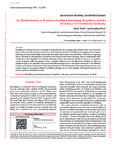The Reintroduction of Beavers to Scotland: Rewilding, Biopolitics, and the Affordance of Non-human Autonomy
| dc.contributor.author | Ward, Kimberley | |
| dc.contributor.author | Prior, J | |
| dc.date.accessioned | 2020-04-23T10:21:26Z | |
| dc.date.issued | 2020-05-29 | |
| dc.identifier.issn | 0972-4923 | |
| dc.identifier.issn | 0975-3133 | |
| dc.identifier.uri | http://hdl.handle.net/10026.1/15593 | |
| dc.description.abstract |
Rewilding is a distinctive form of ecological restoration that has emerged quite publicly within environmental policy and conservation advocacy circles. One of the fundamental tenets of rewilding is its emphasis on non-human autonomy, yet empirical examples that examine non-human autonomy are currently limited. While there is a growing body of literature on the biopolitics of broader environmental conservation strategies, there is comparatively little scholarship on the biopolitics of rewilding. This paper argues that autonomy should not be used as a boundary marker to denote 'wild' non-humans, but as a situated condition that is variable across locations. It offers an empirical study of the biopolitics that govern the different expressions of non-human autonomy at two different locations in Scotland, where beavers have been reintroduced. The findings reveal how, depending on location and context, modes of governance related to rewilding strategies co-exist and interplay with animal autonomy and forms of power in contradictory ways. | |
| dc.format.extent | 103-103 | |
| dc.language | en | |
| dc.language.iso | en | |
| dc.publisher | Medknow Publications | |
| dc.subject | rewilding | |
| dc.subject | reintroduction | |
| dc.subject | beavers | |
| dc.subject | biopolitics | |
| dc.subject | autonomy | |
| dc.subject | more-than-human agency | |
| dc.subject | Scotland | |
| dc.title | The Reintroduction of Beavers to Scotland: Rewilding, Biopolitics, and the Affordance of Non-human Autonomy | |
| dc.type | journal-article | |
| dc.type | Journal Article | |
| plymouth.author-url | https://www.webofscience.com/api/gateway?GWVersion=2&SrcApp=PARTNER_APP&SrcAuth=LinksAMR&KeyUT=WOS:000542133700004&DestLinkType=FullRecord&DestApp=ALL_WOS&UsrCustomerID=11bb513d99f797142bcfeffcc58ea008 | |
| plymouth.issue | 2 | |
| plymouth.volume | 18 | |
| plymouth.publication-status | Published | |
| plymouth.journal | Conservation and Society | |
| dc.identifier.doi | 10.4103/cs.cs_19_63 | |
| plymouth.organisational-group | /Plymouth | |
| plymouth.organisational-group | /Plymouth/Faculty of Science and Engineering | |
| plymouth.organisational-group | /Plymouth/Faculty of Science and Engineering/School of Geography, Earth and Environmental Sciences | |
| plymouth.organisational-group | /Plymouth/REF 2021 Researchers by UoA | |
| plymouth.organisational-group | /Plymouth/REF 2021 Researchers by UoA/UoA14 Geography and Environmental Studies | |
| plymouth.organisational-group | /Plymouth/Research Groups | |
| plymouth.organisational-group | /Plymouth/Research Groups/Centre for Research in Environment and Society (CeRES) | |
| plymouth.organisational-group | /Plymouth/Research Groups/Centre for Research in Environment and Society (CeRES)/CeRES (Reporting) | |
| plymouth.organisational-group | /Plymouth/Users by role | |
| plymouth.organisational-group | /Plymouth/Users by role/Academics | |
| dcterms.dateAccepted | 2020-03-07 | |
| dc.rights.embargodate | 2020-5-29 | |
| dc.identifier.eissn | 0975-3133 | |
| dc.rights.embargoperiod | Not known | |
| rioxxterms.versionofrecord | 10.4103/cs.cs_19_63 | |
| rioxxterms.licenseref.uri | http://www.rioxx.net/licenses/all-rights-reserved | |
| rioxxterms.licenseref.startdate | 2020-05-29 | |
| rioxxterms.type | Journal Article/Review |


